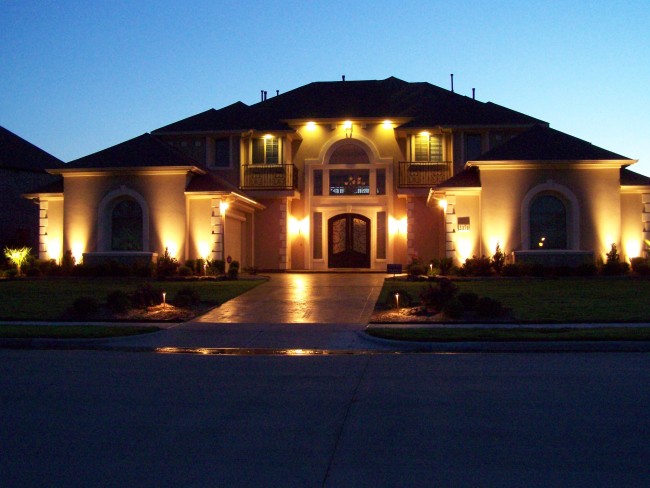
Lighting installation varies quite a bit depending on the individual demands of different projects. Some of today’s most popular lighting projects, like low-voltage lighting installation, are simple enough that many homeowners choose to do it themselves; others, like recessed lighting installation, are simple in theory, but difficult to get right. The following facts and tips about low-voltage, recessed, and under cabinet lighting installation are meant not only to describe the processes, but to help you decide which of these projects are right for you, and whether or not you will need any professional help to complete them.
Low-voltage Lighting Installation
There are several reasons why low-voltage lighting installation is an attractive project for so many homeowners. Not only do low-voltage lighting installations use less electricity than conventional lighting, their soft, subtle glow is the perfect compliment for many situations where traditional lighting installations would seem overpowering.
One of the most attractive characteristics of low-voltage lighting installation is its relative ease when compared to the hassle of installing traditional lighting. In fact, manufacturers of low-voltage lighting have produced kits to make this task even more DIY friendly. As long as you have a GFCI receptacle, the kit will give you exact instructions on how to install low-voltage lighting in any area of the home. These kits, and low-voltage lighting installation in general, are particularly well suited to outdoor settings, where the softer lighting will provide the perfect accent without draining your wallet or creating an unpleasant glare.
Under Cabinet Lighting Installation
For both aesthetic and space-saving reasons, under cabinet lighting installation is becoming an extremely popular choice for kitchens, bathrooms, and any other area where eye-level cabinetry exists. In kitchens (by far the most common area of the house for under cabinet lighting installations), the beauty of this design is two-fold: Not only does it give you a lighting option other than harsh, overhead fixtures, it also focuses light directly over counter work spaces, giving you more effective illumination when using the cutting board, plating, or cleaning.
Under cabinet lighting installations are only as complex as you make them. At their simplest, small, individual fluorescent light fixtures (with individual on/off switches) that plug into a wall socket are simply screwed in place to the bottom face of your cabinetry. Quite an easy job for even less-than-handy homeowners! Higher-end under cabinet lighting installations are better left to the professionals, however, as they require the running and connecting of new wiring. The benefit of these professional installations is that your under cabinet lighting is free of power cords and is operated using a regular wall switch.
Ready to start your lighting project?
Find ProsRecessed Lighting Installation
In living rooms and bedrooms, recessed lighting installation is a project most often done to make smaller spaces appear larger. Instead of having a bulb and light fixture that juts down from the ceiling, with recessed lighting, installation occurs above the ceiling. Though it doesn’t seem like a huge difference on paper, when done properly, recessed lighting installation literally brings more depth to the room, and creates a more spacious feeling that equals more than the sum of its parts.
Unless you have experience in both carpentry and wiring, recessed lighting installation is a project that is nearly always better left to the professionals. The visual effect that is created is a crucial part of why homeowners choose recessed lighting in the first place, and any less-than-professional workmanship is bound to detract from that effect. Thankfully, when you hire a pro for this job, the results are typically more attractive than you would imagine, and the work gets done faster, too!
Deck Lighting
The best way to provide low intensity light that maximizes both safety and your “porch sitting” experience is to utilize a number of different fixtures when you design your new low voltage deck lighting. Here’s a list of the most common fixtures and their most popular uses.
- Accent Lights are lights that focus their light downward to illuminate decking, stairs, and edges. They can be installed on posts, railing or stairs, and come in a large number of styles to fit just about any personality.
- Post Lights sit on top of deck posts or railings. They provide the largest amount of light to the greatest amount of space, making them ideal for use at the top and bottom of stairways, steps, and other potentially hazardous areas.
- Recessed Lights are lights that are actually installed into the floor of your deck. These small, low intensity lights are excellent for installation around edges and on either side of stairs to clearly illuminate where your deck ends and the rest of the world begins.
- Rope Lights are a string of low-intensity lights fitted into a clear pvc tube. Rope lights are perfect for installation on the underside of railings, down stairways, or any other place you want to accent a run of your deck.
By incorporating all these different styles of lights into your deck lighting plan, you’ll ensure a more pleasant deck experience and a safer place to spend your time. Talk to a lighting retailer or a contractor about designs, planning and installation, and enjoy the warm, comforting atmosphere your new lights will provide for years to come.
 Electrical Wiring Project Checklist
Electrical Wiring Project Checklist  How to Wire a Light Switch
How to Wire a Light Switch  Track Facts: What To Know about Track Lighting Fixtures
Track Facts: What To Know about Track Lighting Fixtures  The History of the Light Bulb in Your Home
The History of the Light Bulb in Your Home  Adding a Home Wet Bar
Adding a Home Wet Bar 

Are You Familiar With This Topic? Share Your Experience.